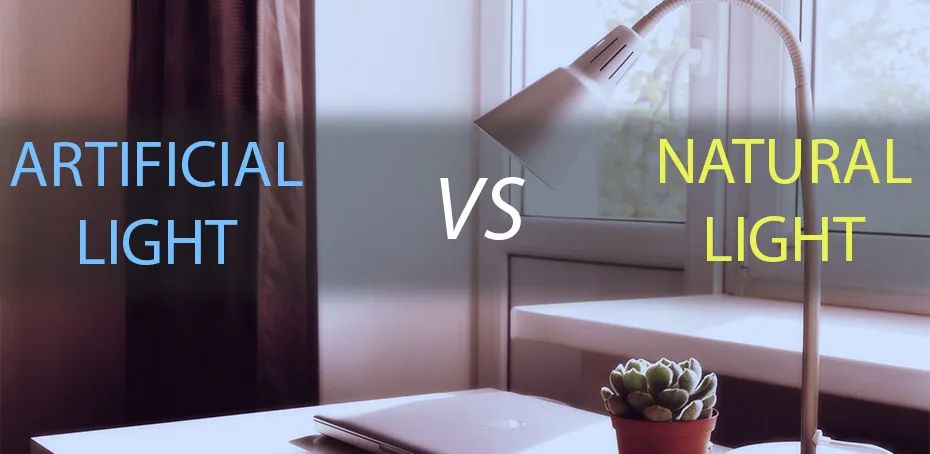
Knoop, M., Stefani, O., Bueno, B., et al. (2020). Daylight: What makes the difference? Lighting Research & Technology, 52(3), 423-442.
Daylight is the holistic combination of the luminous characteristics of sunlight from direct solar radiation and skylight from diffuse solar radiation (Figure 1). Unlike electric lighting, daylight is highly dynamic, changing within and across days, throughout the year, and with weather conditions in intensity, colour, diffuseness and direction. Daylighting refers to the illumination of indoor spaces by daylight delivered through openings in the building skin.

This article arose from discussions between the authors at a seminar held in Berlin in June 2018 and is not intended to be a comprehensive review paper. The purpose of the seminar was to reflect an interdisciplinary discussion on the various scientific, technical and creative aspects of the differences between daylight and electric light. As a first step, this overview should provide a basis for further, more specific discussion and research.
Numerous survey-based studies have shown that daylight is preferred to electric lighting in most settings[1-5]. Boyce et al [6] state that ‘There is no doubt that people prefer daylight over electric lighting as their primary source of illumination’ and provide an overview of literature which shows that high percentages of survey respondents prefer to work by daylight. Most studies were performed at latitudes around 50°N [2,3,7]; one study in the tropics indicates that the majority of occupants prefer to work under daylight as well [8].
Many reviews document the importance of daylight for health, well-being, and sustainability and the consequences for architecture [5-13]. Veitch and Galasiu [11] summarise: 'The reviews [5,14] concluded that windows and daylighting are desired by most employees and that they are contributors to health and well-being’. Here we show that the specific characteristics and related benefits of daylight as summarised in Table 1 that produce this human reaction go beyond subjective preferences for natural light, as discussed by Haans [15].
许多综述论文记录了天然光对健康、福祉和可持续性的重要性,及其对建筑的影响。Veitch和Galasiu总结道:“办公空间中大多数员工希望拥有窗户和自然采光,它们对健康和福祉有积极贡献。”本文进一步指出,天然光的特定特征及其带来的益处(总结于Table 1)超出了人们对天然光的主观偏好,正如Haans所讨论的那样。
Table 1 Characteristics of daylight and electric lighting
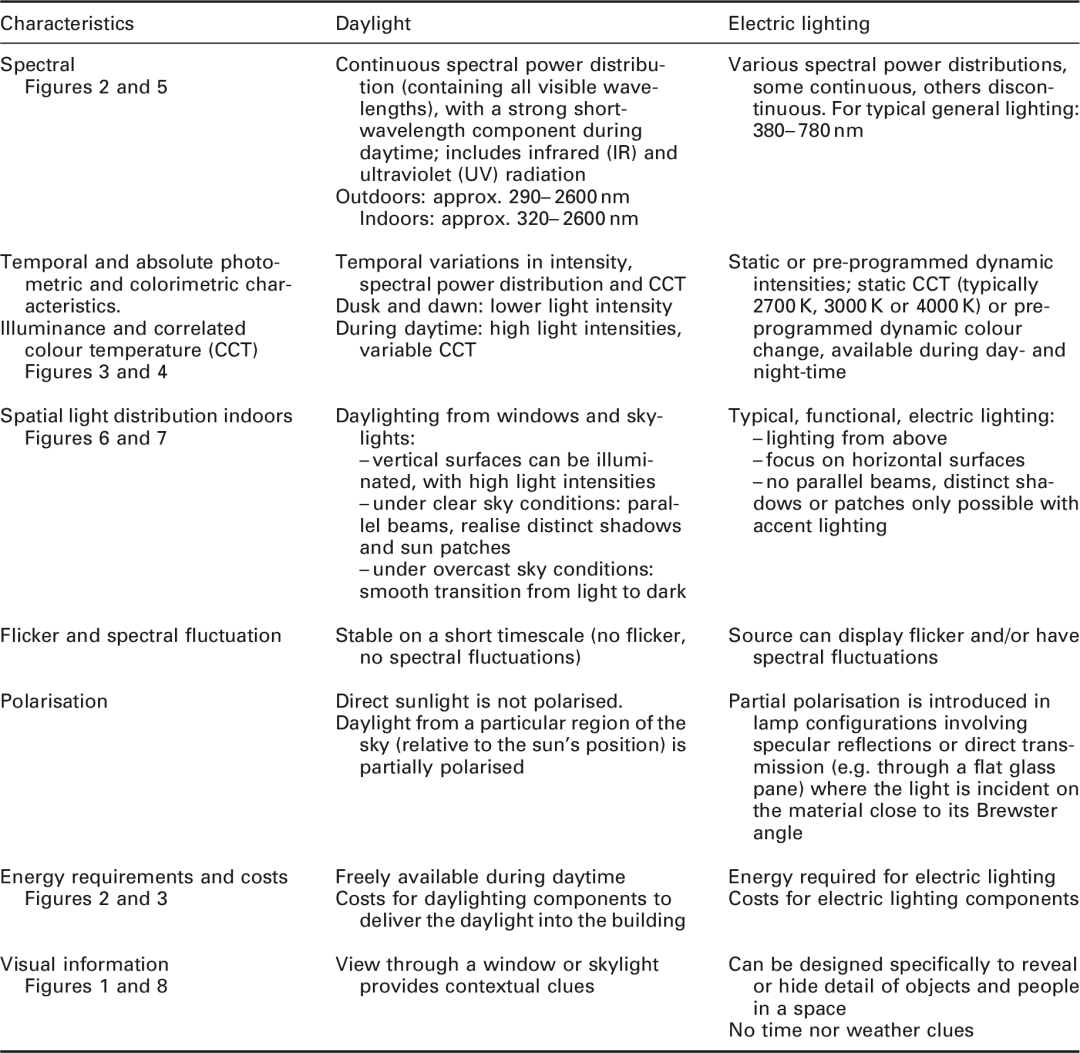
Underlying the human preference for daylight are experiences that transcend immediate physical stimuli, often orchestrated by their nature to be interwoven with context-related knowledge. The sun has been worshiped in many cultures, with sunlight and the qualities of shadows and darkness being generally felt to be a source of spiritual and aesthetic experience as well as of health and well-being.
人们偏爱天然光的底层原因是超越即时物理刺激的体验,这些体验常常与情境相关的知识交织在一起。太阳在许多文化中被崇拜,阳光和阴影、黑暗的品质通常被视为精神和审美体验的来源,同时也是健康和福祉的源泉。
Unlike daylight, electric lighting is a controllable man-made light source associated with advances in science and technology that is easier both to study and to engineer to achieve specific outcomes. In contrast, daylight as a natural source is more difficult to control and the daily, seasonal and annual dynamics of daylight produce different outcomes in different locations, additionally modified by weather conditions. Due to these geographical differences, appropriate daylight utilisation can vary from sun- and skylight exposure to complete exclusion of sunlight from buildings.
与天然光不同,电光源是一种可控的人造光源,是科技的产物,更容易被研究、被设计、被工程应用,以实现特定的结果。相比之下,天然光作为一种自然的产物,更难以控制,其日间、季节和年度动态变化在不同地点会产生不同的结果,还会额外受天气条件影响。由于这些地理差异,适当的天然光利用差异很大:从太阳光和天空光暴露,到完全遮挡太阳光直射。
In addition,the use of daylight openings in the building envelope depends on the function of the indoor space, as well as occupants’ requirements for privacy, view, glare protection and solar heat gain management. Individuals also respond differently to daylight, as for example reviewed by Pierson et al [16]. A complex construct of individual, physiological, cultural, geographical and seasonal preferences and characteristics underlies the desire for daylight, and the subsequent human response, as well as the environmental and monetary benefits.
此外,建筑围护结构中采光口的使用取决于室内空间的功能,以及居住者对隐私、视野、眩光防护和太阳得热管理的要求。个体对天然光的反应也各不相同,比如Pierson等所综述的那样。人们对天然光的渴望和反应,其背后的原因很复杂:综合了个体、生理、文化、地理、季节各方面的偏好和特征,以及环境和经济效益等因素。
2. Visual Performance 视觉功效
Vision is the most developed sense in humans and, therefore, our species significantly relies on the provision of light of adequate quality. Visual performance, defined as the speed and accuracy of processing visual information, is influenced by lighting conditions [17]. Daylight is a very good light source to support visual performance. It is a flicker-free light source with a continuous spectral power distribution covering the full visible range (Figure 2).
视觉是人类最发达的感觉,因此我们人类显著依赖于适当质量的光。视觉功效被定义为处理视觉信息的速度和准确性,它受到照明条件的影响。天然光是一种能够支持视觉表现的优秀光源,它是一种无频闪的光源,具有覆盖整个可见光谱范围的连续光谱功率分布(Figure 2)。

The high illuminances (Figure 3) enable discrimination of fine details supporting visual acuity. Glare must be controlled both for daylight and electric light. The spectral power distribution of daylight offers optimal colour rendering and allows better colour discrimination than most electric lighting, whilst the directionality of both daylight and electric light can produce shadows that enhance details for three-dimensional tasks.
高照度(Figure 3)能够支持辨别细节的视锐度。天然光和电光源的眩光都是要控制的。天然光的光谱功率分布提供了最佳的色彩还原效果,并且能够比大多数电光源更好提供色彩辨别力;天然光和电光源的方向性都可以产生增强细节的阴影,有助于三维视觉任务。

3. Good Eyesight 良好视力
Lack of daylight exposure seems to be linked to developing myopia or short-sightedness. Myopia is the most common visual disorder affecting young people; it has reached epidemic levels in East Asia and is increasing elsewhere. Myopia is normally first diagnosed in school-age children. Recent studies have revived the idea that it is the environment in which children learn that determines whether or not they become short-sighted [18]. It seems that children who engage in outdoor activities have lower levels of myopia [19]. Thus, daylight exposure at levels significantly higher than those typically found indoors (Figure 3) may be important in preventing myopia.
缺乏天然光照似乎与患近视有关。近视是影响年轻人的最常见视觉障碍,它在东亚地区已达到流行病的水平,并且在其他地方也在增加。近视通常在学龄儿童中首次被诊断出来。最近的研究重新激活了这样一个观点:是学习的物理环境决定了他们是否会变得近视(iLLab注:之前很长一段时间学界都认为近视是因为用眼过度,而跟环境关系并不大。)。那些户外活动较为充足的儿童近视水平也较低。因此,显著高于室内典型照度水平的天然光暴露(Figure 3)可能对预防近视起重要作用。
The precise biological mechanisms through which being outdoors may protect children's eyesight are not yet fully understood. The hypotheses are that (i) bright light stimulates the release of the retinal neurotransmitter dopamine, which inhibits the axial growth of the eye that causes short-sightedness; (ii) since circadian rhythms in the eye affect ocular growth, disruption of such rhythms by low light levels has also been proposed as a development factor [20] and (iii) there is a geographical, seasonal, component, as both eye elongation and myopia progression increase as day-length shortens [21]. The complex protective effect of daylight may depend on many interlinked aspects including duration and timing of daylight exposure, wavelength and intensity.
天然光对儿童视力保护作用的精确生物学机制尚不明确,但有相关的三个假说:(i)强光可以刺激视网膜神经递质多巴胺的释放,从而抑制会导致近视的眼轴增长;(ii)由于眼睛中的昼夜节律影响眼球生长,低光照水平扰乱这些节律也被认为一个发展因素;(iii)存在地理和季节性因素,因为随着白昼缩短,眼轴增长和近视发展都有所增加。天然光的复杂保护效应可能依赖于许多相互关联的方面,包括天然光暴露的时长和时机,及其波长和强度。
Excessive near-work may also damage children's eyesight; even though evidence for this is inconsistent, a recent review of myopia prevention by Lagrèze and Schaeffel [22] reported that ‘A person with little exposure to daylight has a fivefold risk of developing myopia, which can rise as high as a 16-fold risk if that person also performs close-up work’.
过度的近距离(iLLab注:视觉任务)工作也可能损害儿童的视力;尽管相关证据并不一致,但Lagreze和Schaeffel最近对近视预防的综述报告称:“很少接触天然光的人患近视的风险是平均水平的五倍,如果这个人同时还从事近距离视觉任务的工作,风险会高达16倍。”
The spectral component of daylight exposure (Figure 2) may affect visual colour performance. Reimchen [23] showed that colour deficiencies are more common in northern latitudes, where twilight occupies a more significant part of the day than at the equator, where colour deficiencies are very uncommon. A study of visual perception in individuals born below and above the Arctic Circle, in different seasons, indicated that a reduction of daylight and an increase of exposure to twilight and electric lighting during infancy changed colour sensitivity; participants born in autumn above the Arctic Circle showed the lowest overall colour performance [24].
天然光照的光谱成分(Figure 2)可能影响颜色方面的视觉功效。Reimchen的研究表明,色觉缺陷在北纬地区更为常见,而在赤道地区色觉缺陷很罕见。相比赤道地区,北纬地区的晨昏弱光占据了一天中更长的时间。一项对在北极圈附近不同季节出生的个体的视觉感知研究显示,在婴儿期天然光暴露减少、晨昏弱光和电光源的暴露增加,会改变颜色视觉敏感性;在秋季出生且生活在北极圈以外的婴儿的颜色视觉功效是最低的。
4. Circadian Entrainment 昼夜节律
Well-timed lighting can entrain the circadian system, which is important for positively affecting an individual's sleep quality, health, mood and cognitive abilities [25]. Daylight, due to its temporal variations in spectral power distribution and intensity (Figure 4), is the natural time cue (‘zeitgeber’) for synchronisation of the circadian system and the sleep–wake cycle. Dawn and dusk are important cues for entrainment with high light levels during the day followed by darkness at night being essential for optimal sleep.
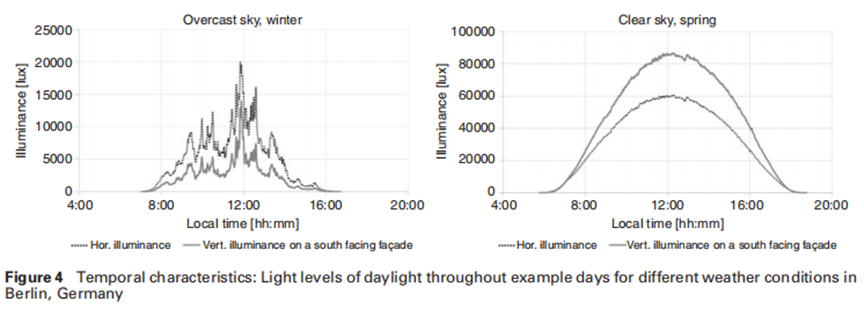
Light input to the circadian system occurs through intrinsically photosensitive retinal ganglion cells (ipRGCs) particularly sensitive to the short-wavelength ‘blue’ component of light. Discovered in 2002 [26,27] these cells are connected to the circadian clock and other parts of the brain, affecting primarily non-visual functions [28]. To support circadian functionality, bright and short-wavelength light exposure during daytime is important together with avoidance of light during nighttime. A study in the Antarctic region showed better sleep quality of base personnel during the period of the year with daylight, with its prevalent higher light levels, compared to sleep quality during the polar winter with only electric lighting. When comparing electric lighting conditions, blue-enriched (17,000 K) light was more efficient than bright white (5000 K) in supporting good sleep–wake cycles [29]. In interiors, reduced exposure to sunlight during the day together with electric light exposure after sunset can delay timing of the circadian clock leading to difficulties falling asleep at night and problems getting up on time in the morning.
光对昼夜节律系统的作用主要通过内在光敏性视网膜神经节细胞(ipRGCs)实现,这些细胞对短波长的“蓝光”成分特别敏感。这些细胞于2002年被发现,它们与生物钟和其他大脑区域相连,主要影响非视觉功能。为了维持昼夜节律,白天需要明亮且富含短波长的光照,同时夜间需要避免光照。一项在南极地区进行的研究显示,基地人员在有天然光的时期(光照水平较高)的睡眠质量更好,而在极夜期间(只有电光源)的睡眠质量较差。在比较电光源条件时,富含蓝光(17,000 K)的光照比明亮的白光(5000 K)更有效地支持良好的睡眠-觉醒周期。在室内环境中,白天减少阳光暴露,加上日落后使用电光源,可能会延迟昼夜节律的时间相位,导致夜间入睡困难和早上起床困难。
Exclusive exposure to daylight synchronises the circadian system to solar time [30,31]. Roenneberg and Merrow [32] proposed to treat and prevent circadian misalignment by ‘strengthening light environments (more light during the day and less light during the night). This requires taking advantage of dynamic changes in spectral composition, and applying architectural solutions to get more daylight into buildings’. To artificially provide the high-amplitude temporal dynamics of daylight by means of electric lighting requires significant energy use. It is assumed that daylight is the best and appropriate light source for circadian entrainment, though conclusive research evidence for this is lacking.
纯天然光暴露可以将昼夜节律系统与太阳时间同步化。Roenneberg和Merrow提出,通过“强化光环境”(白天更多光照,夜间更少光照)来治疗和预防昼夜节律失调。这需要利用光谱成分的动态变化,并采用建筑设计方案将更多天然光引入建筑中。通过人工照明提供类似天然光的高振幅动态变化需要很高的能耗。这里默认的前提是认为天然光(iLLab:意思是包括昼夜期间的全部天然光,包括诸葛亮和诸葛暗)是昼夜节律调节的完美光源,但缺乏明确的研究证据。
Dawn and dusk signals are the most powerful zeitgebers, not requiring high intensity light but a pattern of diurnal change with sunrise and sunset. They depend on day of year and latitude. Simulation studies have shown a rapid phase advance with a single dawn pulse [33], and exposure to natural dawn and dusk immediately re-positions sleep to within the night [31]. Compared to static lighting, dynamic lighting simulating a natural sunrise through a change of colour temperature (from 1090 K to 2750 K) and illuminance at the eye (0–250 lx) resulted in better subjective mood and well-being [34], better cognitive performance [35] and could be a potential protector for cardiac vulnerability in the critical morning hours [36]. Dynamic lighting that included lower lighting conditions and colour temperatures in mornings and evenings resulted in significantly higher melatonin production 1 hour prior to bedtime compared to static light [37].
黎明和黄昏信号是最强大的时间线索(授时因子),需要的不是高强度的光照,而是昼夜交替时日出和日落的变化模式。这些信号取决于一年中的日期和地理位置。模拟研究表明,单个黎明脉冲就可以快速使昼夜节律相位提前;而暴露于自然的黎明和黄昏中,可以立即将睡眠周期重新归位到夜间。与静态照明相比,模拟自然日出的动态照明(通过色温1090-2750 K变化以及眼位照度0-250 lx变化)可以改善主观情绪和幸福感、提升认知表现,并可能在关键的早晨时段保护心脏免受脆弱性的影响。可以在早晚提供低照度低色温的动态照明,与静态照明相比,可以在睡前1小时显著提高褪黑素的分泌水平。
Daylight outdoors intrinsically provides temporal dynamics. Thus, the simplest solution to getting enough circadian stimulus is to go outside. Nonetheless, people in the modern, industrialised, society spend up to 90% of their time indoors [38–41]. In buildings, the form and façade, as well as the choice of glazing material in the windows and shading system modify intensity, colour and distribution of daylight in the interior. Daylighting conditions available to the occupant of a room also depend on their distance from the window, the geometry of the room and surface reflectances. Depending on the daylighting design, indoor daylight can often provide an adequate stimulus and support to the circadian system, thus remaining as the usual light source for circadian support. Office workers with access to windows have reported better sleep quality than those without windows [42]. Sleep quality increases with higher daylight availability in summer [43], with the duration over a threshold of 1000 lx or 2500 lx at eye level being an indicator for better sleep quality [44].
室外天然光可以提供内在的时间动态变化。因此,获得节律光刺激最简单的方案就是“走出去”。然而,在现代工业化社会中,人们在室内度过高达90%的时间。建筑的选型、立面、窗户玻璃材料和遮阳系统等,都会改变进入室内的天然光的强度、颜色和分布。房间使用者能够获得的天然光条件也取决于他们与窗户的距离、房间的几何形状和表面反射率。根据采光设计的不同,室内天然光通常足以完成昼夜节律的驱动和调节,因此室内采光一直作为维持昼夜节律的常用光源(iLLab注:意思是不太需要额外的所谓“节律照明”)。有窗办公空间的工作人员的睡眠质量报告比无窗的要更好。如果将持续时间超过一定阈值的1000或2500 lx(眼位照度)的光暴露作为与睡眠质量相关的指标的话,那么睡眠质量随着夏季白天时间的增加而提高(iLLab注:这也是北欧高纬度地区在秋冬季对季节性情绪障碍开展人工光照干预疗法的原理)。
Comparing daylight to electric lighting conditions, Turner et al. [45] state: ‘Typical residential illuminance [on average 100 lux or less, due to electric lighting] is too low for circadian needs even in young adults. Properly timed exposure to sunlight or other bright light sources is vital for mental and physical well-being in all age groups. […] In general, several hours of at least 2500 lux of blue weighted light exposure (ideally sunlight) starting early in the morning benefit most people. Bright light immediately and directly enhances cognition, alertness, performance and mood, so bright environments throughout the day provide additional benefits, especially for middle-aged or older adults.’
关于天然光和电光源的对比,Turner等人如是说:“典型的住宅光照水平(平均100 lux或更低,电光源)对于昼夜节律需求来说太低了,即使对于年轻人也是如此(iLLab注:老年人需要更高剂量的光照)。适当时间的阳光或其他明亮光源的暴露对于所有年龄段人群的心理和身体健康至关重要。[……]一般来说,从清晨开始,每天数小时高于2500 lux的蓝光加权光暴露(最好是太阳光)对大多数人有益。明亮的光照可以立刻且直接提高认知、唤醒、绩效和情绪;因此,全天保持在明亮环境可以提供额外的好处,尤其是对于中老年人。”
5. Acute, Non-image Forming Effects 即时非成像效应
Circadian responses, such as regulation of sleep timing, are related to retinal-mediated responses to light mediated by the ipRGCs. In addition, some acute effects, such as melatonin suppression, increase of heart rate or alertness, can also be realised by light through the ipRGCs or a combination of photoreceptors [46]. Both intensity and spectral composition of light play a role in inducing or avoiding these effects. Daylight can provide high light levels. However, the spectral power distribution of light from specific regions of the sky can vary widely [47]; indoors, since the daylight received depends on the orientation of a room, the colour of the light can be considerably cooler than the 6500 K cool white often assumed. The related spectral power distribution and short-wavelength component indicate daylight has a high potential to support acute non-image forming effects (Figure 5).
昼夜节律反应(如睡眠时间的调节)与视网膜介导的光反应有关,这些反应主要通过ipRGCs(内源性光敏视网膜神经节细胞)实现。除此之外,一些即时效应(如褪黑素抑制、心率增加或警觉性提升)也可以由光通过ipRGCs或多种感光器的组合作用来实现。光照强度和光谱在诱导或避免这些效应中起着重要作用。天然光能够提供所需的光照强度,但来自特定天空区域的光谱功率分布可能差异很大;因此,由于房间的朝向不同,室内采光的色温可能比通常假设的6500K的冷白光更偏冷。相关的光谱功率分布和短波长成分表明,天然光在支持即时非成像效应方面具有很高的潜力(Figure 5)。
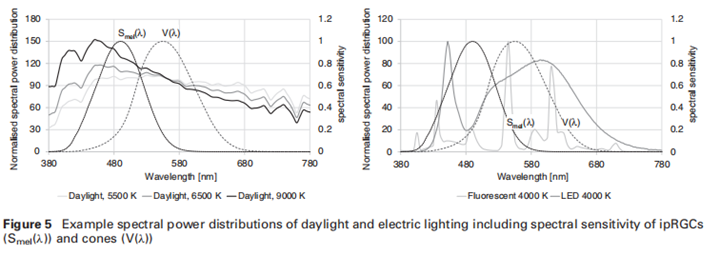
Investigations of these acute non-image forming effects of light have mostly been conducted with electric lighting. It has been shown, for example, that self-reported daytime performance, alertness and ability to concentrate, and reduction of daytime sleepiness, improve under static lighting with high correlated colour temperature[48,49]. Smolders et al. [50] found increased subjective alertness and vitality, as well as objective performance and physiological arousal, when offering 1000 lx instead of 200 lx at eye level in the morning. Even though relevant studies with daylight have been limited, daylight would be expected to very effectively produce acute non-image forming effects during daytime due to the availability of high light levels together with the pronounced short-wavelength component in its spectrum. Though lamps have been specifically developed to support circadian and acute non-image forming effects, daylight is the natural light source to support these effects whilst incurring little, or no, energy use.
关于这些即时非成像效应,大多数研究都是基于电光源的。例如,有两项基于静态人工照明的研究结果表明,高色温可以改善自我报告的昼间工作绩效、警觉性、困倦感和注意力集中程度。Smolders等人发现,当在早晨将眼位照度从200 lx提高到1000 lx时,受试者的主观警觉性和活力有所增加,同时客观绩效和生理唤醒也有所提高。尽管在即时非成像效应方面,基于天然光的研究不多,但由于其在白天能够提供高照度水平和短波光谱成分,天然光在这方面的作用有很高的预期。尽管目前有专门面向昼夜节律和即时非成像效应而开发的电光源产品,但天然光仍然是可以支持这些效应且零能耗或近零能耗的天然光源。
6. Room, object and human apperance 房间、物体和人的外观
The multiple characteristics of daylight (both sunlight and skylight) affect room, object and human appearance, providing a specific perceived room ambience that can influence the occupants’ emotional state. There is no conclusive research on the impact of dynamic changes of directionality and diffuseness due to variations of sunlight and skylight entering built environments. However, users of a space are sensitive to the intensity, direction and diffuseness of light in a space [51].
天然光(包括太阳光和天空光)的多重特性会影响房间、物体和人体外观,营造出一种特定的感知氛围,从而影响使用者的情绪状态。关于建筑环境中太阳光和天空光在方向性和漫射性上的动态变化而导致的影响,目前尚无结论性的研究。但是,人对空间中的光照强度、方向性和漫射性是非常敏感的。
Electric light systems usually deliver light from a number of points distributed over a space leading to light rays of various intensities and directions creating overlapping shadows that can be perceived as visual noise. Conversely, daylight is delivered through a window or a skylight, which has a main direction inward to the room from the opening in the building skin. This creates visual clarity that can provide an impression of serenity of the space. The spatial light distribution also affects room appearance, as well as the perceived representation of objects and human faces. The appearance of faces of people seated near the window, side-lit by daylight, has been shown to be labelled with positive attributes, and high luminance contrasts are not perceived as disturbing [52].
电光源系统通常通过分布在空间中的多点提供光线,这些光线的强度和方向各不相同,形成重叠的阴影,可能会被感知为视觉噪声。相比之下,天然光通过窗户或天窗进入室内,从建筑表皮的开口处向室内投射有主方向的光线。这种光线能够创造出视觉上的清晰感,从而给人以空间的宁静感。空间光照分布也会影响房间外观,以及物体和人脸的视觉呈现。研究表明,靠近窗户、被天然光侧向照亮的人的脸部,会被赋予积极的属性,而且这种高亮度对比度并不会让人感到烦人(iLLab注:用川渝方言的“恼火”更精准)。
Due to the size of a window, shadows are typically ‘soft’, which is considered appropriate for good modelling [53]. In addition, the light from the side, or a lateral ‘flow’ of light, seems to be preferred in the perception of human faces and objects; daylight through windows is effective in realising such spatial light distributions (Figure 6)[54–56].
由于窗户的尺寸较大,形成的阴影通常是“柔和”的,被认为适合良好的造型。此外,来自侧面的光线或光线的“流动”似乎在感知人脸和物体时更受青睐,而天然光通过窗户能够有效地实现这种空间光照分布(Figure 6)。
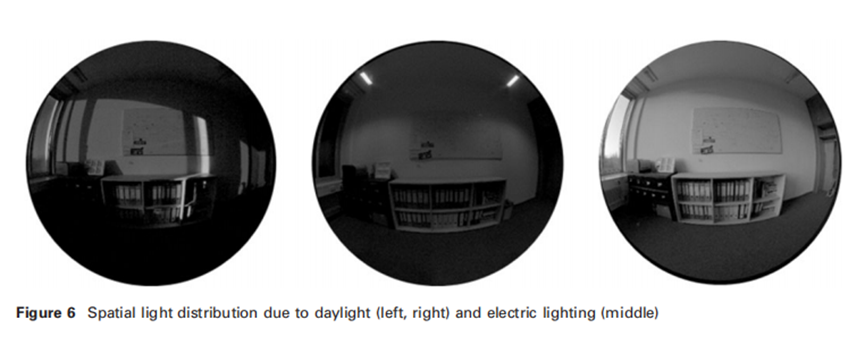
Research under electric lighting conditions showed that brightness of room surfaces, preferably greater than 30–40 cd/m² in a horizontal band of 20° above and below the line of sight, give visual lightness and attractiveness to office rooms [57–60]. Also important for perceived spaciousness is the amount of light [61,62], with wall-oriented lighting alone or a combination with a low level of overhead lighting seemingly beneficial for spaciousness [61,63]. A full-scale study (Figure 7) of a series of room quality attributes showed that high levels of daylight from large windows are crucial in order to achieve a more pleasant, exciting, complex, legible, coherent and open room [64].
在电光源条件下进行的研究表明:房间表面的亮度(优选在视线水平上下20°的水平带内大于30–40 cd/m²)可以为办公室带来视觉上的轻盈感和吸引力。光照量对于感知空间感也很重要的,单独的墙面照明或与低水平的顶面照明相结合,似乎有益于空间感(iLLab注:宽敞感)。一项关于空间质量属性的全尺寸研究(Figure 7)表明,来自大窗户的高照度天然光对于营造一个更令人愉悦、兴奋、更复杂、更连贯、更清晰易读的空间至关重要。
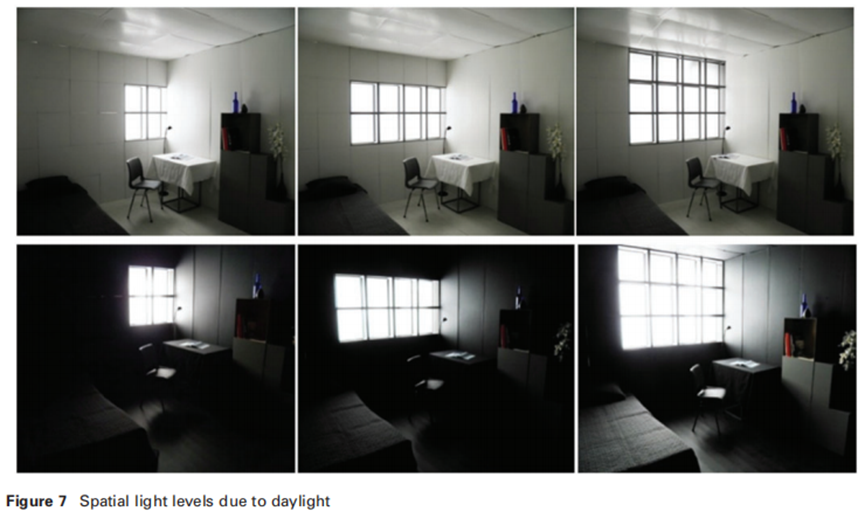
Direct sunlight affects room appearance with a sun patch as well as clearly defined shadows produced by parallel beams of sunlight. Whilst the sun patch is seen as a visual stimulus, research suggests that appropriate sunlight penetration can induce relaxation [65]. Sunlight penetration was found to have a positive effect on job satisfaction and general well-being [66]. A social survey in four different building types by Ne’eman et al. [67] showed that sunshine has ‘a unique non-physical property which induces psychological wellbeing’.
One study used an artificial sky to mimic daylight of a clear sky with defined (blue-toned) shadows, a sun patch (producing a brightness ratio for the sunlight to shaded areas as found outdoors), as well as a bright light source seen through the window (having the appropriate perceived size of the sun) [68,69]. The results indicated that these lighting characteristics had a positive effect on perceptions of room appearance and the mood, stress and anxiety levels of participants. Sunlight falling directly on the occupant or reflected from a surface can cause visual and/or thermal discomfort. This discomfort is linked to blind usage [70], which will then block (part of the) direct sunlight and skylight from entering the building.
Though most research on space and object appearance has been conducted using controlled electric lighting, the results are applicable to daylight conditions. The research included in this section has mainly been performed in temperate climates and indicates that the spatial lighting realised by daylight supports good perception of room and object appearances. Direct sunlight seems to enhance perceived room ambience and the user's emotional state, when visual and thermal comfort are maintained. Façade design considerations to maintain comfort in tropical regions will affect indoor daylight conditions. Both the resulting room and object appearance, as well as the prevalence of sunny conditions might result in different subsequent occupant responses.
尽管大多数关于空间和物体外观的研究是基于电光源开展的,但这些结果也适用于天然光条件。本节中包含的研究大多数是在温带地区开展的,因此结果表明由天然光实现的空间光分布有利于形成人对房间和物体外观的良好感知。当视觉舒适和热舒适性没有被破坏时,阳光直射似乎可以强化空间的氛围感知和使用者的情绪状态。对于热带地区来说,立面设计的主要考量是保证舒适,这将影响室内的天然光条件。由此得到房间和物体外观,以及晴天概率,可能会导致不同的使用者反应(iLLab注:相比于温带地区而言)。
The specific spectral power distribution and brightness of daylight can also affect human physical comfort. Physical comfort is the feeling of well-being, when an environment's thermal and lighting conditions are experienced as pleasant and associated with satisfaction. The brightness and the strong infrared component of daylight (Figure 2) may be appealing, but can cause visual and thermal discomfort. Nonetheless, interviews in field studies showed that occupants can be satisfied with daylight even though they sometimes experience visual discomfort [71].
Sunlight penetration heats up a room. In addition, windows are a source of heat transfer from and to the exterior. Differences between temperate zones and the extremes of polar or equatorial regions are typically reflected in architectural solutions, as the design approach should be different to give comfortable indoor environmental conditions [72].
Thermal discomfort due to high or low temperatures activates biological cooling (e.g. sweating) or heating (e.g. shivering), respectively. Discomfort can also arise from the thermal asymmetry between the temperatures of the cool internal surfaces of windows and those of warmer walls [73]. A field study by Chinazzo et al [74] indicates that satisfaction with the temperature in the room is affected by lighting conditions, with a lower satisfaction under lower lighting levels. This could suggest a greater tolerance for thermal discomfort in situations with daylight, as previously proposed by Veitch and Galasiu [11].
Visual discomfort, referring to ‘discomfort or pain in or around the eyes’ (according to Boyce and Wilkins [75] ), can have several causes, including glare and flicker from the light source. Glare can impact visual performance, but even glare that does not necessarily impair seeing objects can lead to fatigue. Research on discomfort glare due to high luminances or luminance contrast from daylight or electric lighting indicates a greater tolerance when mild discomfort glare arises from daylight [76,77] and/or a diversity of individual requirements for visual comfort from daylight [78] than met from electric light sources with the same luminance. Culture and climate are suggested to influence perceived glare from daylight [79]. Flicker can cause headaches, eye strain or seizures, and reduce visual performance [80]. Electric lighting can be a source of flicker, whilst daylight is flicker-free.
视觉不舒适(根据Boyce和Wilkins的定义,指“眼睛周围或眼睛内部的不适或疼痛”)的诱因有很多,包括光源的眩光和频闪。眩光可能会影响视觉功效,有些眩光即使不会妨碍看清物体,但也可能会导致视疲劳。有研究表明,同样是由天然光或电光源产生的高亮度或高亮度对比度所引起的不舒适眩光,当其来自于天然光时,人们的容忍度更高。同时,人们对天然光视觉舒适性的个体需求的多样性,也比相同亮度的电光源更大。文化和气候条件也会影响人们对天然光眩光的感知。频闪会引发头痛、眼睛疲劳或癫痫发作,并且降低视觉功效。电光源可能是频闪的来源,但天然光是没有频闪的(iLLab注:在眩光方面天然光有优势,在频闪方面天然光优势更明显)。
A window offers daylight, air exchange, a view, and information on the weather and activities outside. Window material properties, design and usage offer control over outdoor influences, such as smell, sound and heat. In addition, windows may provide an escape route. All these aspects play a role in the feeling of control and safety in indoor environments. Enclosure, privacy, safety and (subconscious) knowledge of escape routes relate to the functionality of a space. Stamps [81] states that lightness of a scene is related to judged safety (‘ability to move and the ability to perceive’). No information about the weather and lack of a view were the reasons female office workers dislike windowless offices, having feelings of isolation, depression and tension (Ruys, reported in Collins [1] ).
The view from a window can affect several aspects of physical and mental well-being. It can, for example, support restorative processes, relieve stress or increase job satisfaction. Research investigating the effects of view content suggests that busy and dense urban areas with obstructions giving a short visual range require constant accommodation and adaptation processes by the eye muscles, to keep an image fixed at the fovea. Conversely, views into a deep space can relieve the eye and the muscle tonus, and free the cerebral cortex from processing information, leading to cognitive relaxation. Looking at a view speeds-up physiological recovery from a stressful experience [82,83].
窗外的景观可以影响身体和心理的多个方面。例如,它可以支持恢复性过程、缓解压力或增加工作满意度。对景观内容的研究表明,繁忙且密集的城市区域,若有障碍物导致视觉范围较短,则需要眼睛肌肉不断调节和适应,以将图像固定在视网膜的中央凹。相比之下,远眺可以放松眼睛和肌肉紧张,并使大脑皮层免于处理信息,从而实现认知上的放松。观景可以加速从紧张感中恢复回来的生理进程。
Less information is available comparing the relative restorative benefit of rooms with window views, artificial windows and windowless walls. Office occupants have a preference for real windows or an artificial window with a dynamic view of nature [84], but the restorative effect of artificial windows with dynamic ‘views’ seems to be lower [85]. In windowless spaces, occupants seem to compensate for the lack of windows with nature elements, in the form of plants or pictures of natural scenery. Heerwagen and Orians [86] found that small windowless offices are decorated with twice the number of visual materials than windowed rooms with views. Visual material (in windowless offices) did not represent ‘surrogate’ views, but did include natural themes.
Windows also offer contextual clues about time of day and about weather conditions, that fix ourselves in time and space, both consciously and unconsciously. Patients in an intensive therapy unit with a translucent window had a more accurate memory and orientation and fewer hallucinations and delusions then those in a windowless unit [87]. A questionnaire to understand the preference for windows showed that the view outside that gave temporal information was amongst the most frequently cited favourable factors for residential spaces and a number of non-residential spaces [88]. According to Veitch and Galasiu [11] ‘This information provision is an acknowledged function of a window’.
Both content and perceived quality of a view can affect human responses to daylight. The number of view layers, the width and distance of the view, the perceived quality of the landscape elements and the composition of the view are important influential parameters as shown in Figure 8 [89]. Tolerance of discomfort glare from daylight through a window is partly determined by how interesting the scene outside is [90,91], its attractiveness [92] and its content [93]. A view outside adds to the desirable perception of daylight, especially for natural, attractive and interesting views, but the mechanisms for this are not yet fully understood. Even though the contextual clues associated with daylight can be emulated, research indicates that some benefits might not be reproduced by electric lighting.
窗景的内容和感知质量都会影响人类对天然光的反应。景观的层次、视野的宽度和距离、景观元素的感知质量及其构图,都是重要的影响参数(Figure 8)。对天然光眩光的容忍程度,部分取决于窗外景观的有趣程度、吸引力及其内容。尽管窗景可以提高人们对天然光感知的预期,尤其是对自然、吸引人且有趣的景观,但其背后的机制尚不明确。天然光所提供的部分信息是可以通过电光源模拟得到,但仍有研究表明有些天然光的好处是电光源复制不来的。

Daylight provision offers cost-free indoor lighting with a continuous spectral power distribution from 320 nm to 2600 nm which has implications for the heating, cooling and lighting energy demand of a building [94]. Daylighting can directly reduce the electric energy required to illuminate a room. The extent to which daylight can displace times of use of electricity is obviously specific to the design, location, purpose and use of a space within a building. Care should be given to the most suitable location of activities, for example highly visual tasks should be done near a naturally lit building perimeter. A daylight design should be combined with electric lighting controls that switch-off or reduce, but maintain the quality of, electric lighting to reduce electricity use. Lighting energy savings achieved through installing daylight responsive lighting controls range from 20% to 70% [95–99]. A meta-analysis by Williams et al [100] showed average savings of approximately 30% in various applications. Tsangrassoulis et al [101] indicate that a 40% reduction in lighting energy consumption can reduce overall primary energy consumption by 17%.
Only when the full potential of such designed-in approaches has been exhausted should consideration be given to the introduction of technological systems to convey daylight deeper into interior spaces by deflection at windows or the, often costly to install, transmission of daylight from a roof through intervening floors by mirrored pipes or fibre optic cables [102–104].(iLLab注:好长的一句话!)
Daylight openings affect thermal conditions in a building. Heat losses in wintertime can increase when the heat resistance of windows is less than walls. Heat gain arises from solar radiation through windows and depends on climate; this might be beneficial in winter but may require additional cooling in summer. The energy saved as well as the cost-effectiveness of daylighting is thus less if cooling energy is required. Modern glazing systems are capable of filtering-out a significant fraction of the infrared component.
Solar heat gains can be modulated with shading devices or switchable glazing systems, which, ideally, should also balance provision of daylight and a view outside, and protection against glare [105]. There are large differences in daylight composition and daylight availability between temperate and equatorial regions for which architectural solutions are usually appropriately defined. The overall energy demand depends on building type, form and construction, occupant activities and patterns together with geographical location, climate, orientation and degree of obstruction [106–108].
Electric lighting requires energy. It may also release heat to the building, depending on the light source that can increase the cooling load but can also decrease heating energy demands. A windowless building is often less energy efficient than one with an appropriate selection and control of well located windows.
电光源需要消耗能源,具体取决于所使用的光源类型。同时,电光源也在建筑中释放热量,从而增加制冷负荷或者减少供暖负荷(iLLab注:具体取决于季节)。无窗建筑的能效通常比有窗建筑更差。
Daylight design can bring monetary benefits by reducing the energy cost of electric lighting and by improving the productivity of building occupants. Daylight can increase the latter by a combination of sharpened vision due to better colour rendering or higher light levels, improved visual modelling of objects and faces, reduction of flicker and/or the provision of contextual clues [109]. Productivity has been shown to increase by 5–15% in companies that have moved into buildings with more daylight [110,111]. However, the exact role of daylight on productivity in these kind of studies is still subject to future research, given the many other factors that change simultaneously with such a move. The impact of daylight on productivity and related aspects, such as absenteeism, can only be investigated in field studies and epidemiological studies [112,113], in which experimental control is difficult and interpretation of results is demanding [5]. For now, insufficient results are available to draw conclusions with respect to the impact of daylight availability on productivity; further research is necessary.
An analysis of annual income and expense data for commercial buildings by Kim and Wineman [114] indicated that views have an economic value. In their study, higher buildings, likely to have a skyline and cityscape views, had higher property values. In interviews, the majority of businesses stated that the view was a consideration in setting rents. A study by Heschong [115] indicated that call centre workers with the best possible view processed calls faster and scored better on tests of mental function when compared with those workers without a view. An analysis of sales in stores with and without skylights by Heschong et al [109] indicated that stores with skylights had an increase in their sales index. Interviews indicated that the skylight unconsciously led to the visual environment being perceived as cleaner and more spacious.
As stated above, the detailed mechanisms behind these and other, secondary, monetary benefits are largely unknown. In addition, an increase in productivity can only be achieved when unwanted effects from daylighting, such as glare, shadows, veiling reflections and overheating, are avoided.
正如上文所述,我们对天然光和直接经济效益及其次级效益背后机制的了解还很浅薄。此外,实现生产效率提高的前提是要避免天然光所带来的负面效果,如眩光、阴影、反射和过热等。
Intensity, spectral power distribution, and the spatial direction and diffuseness of daylight are characteristics that support room and object appearance as well as non-image forming effects. The dynamics of changes in the intensity and colour of daylight naturally support circadian entrainment, mood and alertness. Some human responses, such as non-image forming effects, seem to be well defined. Also the role of sunlight on the skin to support vitamin D production is well established. However, many benefits of daylight and windows cannot yet be explained so straightforwardly. The higher onset of visual discomfort glare in daylight conditions as well as the positive effect of the contextual clues provided by a view are induced by mechanisms that are not well understood. Some responses to light seem to be mediated through both visual and non-image-forming pathways that require further research [116–118].
Even though many characteristics of daylight can be mimicked by electric lighting, it has not been demonstrated that all the diverse holistic positive outcomes associated with daylight can be reproduced artificially. Indeed, the characteristics of the complex interaction of the dynamics of daylight with individual human responses have not been readily quantifiable to-date. They remain key areas that require extensive further research.
We suggest that future studies should address the impact of daylight on the following aspects of human performance, health and well-being that might lead to behaviours translating into monetary benefits:
1. Differential impact of variations in the spectral power distribution and light intensity across the day and seasons at different geographical locations, for example through epidemiological studies further exploring the effect of daylight provision on good eyesight and circadian entrainment, restorative sleep and better health;
2. Differences in the impact of the source of light on room and object appearance, comparing electric lighting, and daylight through windows, skylights or light tubes, which includes the differences between static and dynamic lighting;
3. Statistical estimations of the variance in the impact of daylight with concurrent exposure to electric light, to elaborate their interactions including assessments of light history effects, and to obtain a better insight into the acute, non-image forming potential of daylight;
3. 对天然光与电光源同时暴露时的影响变化进行统计学评估,以阐明它们的相互作用(包括对光历史效应的评估),并更明确地理解天然光在即时和非成像方面的作用潜力。
(iLLab注:以上三点iLLab均有同步开展的相关研究:人因照明、仿天然光、采光照明一体化。)
1. Qualitative assessments of the perception of an (e.g. work) environment to study the role of context and content under different lighting regimes including the absence of light and whether symptoms of such absence can be quantified/operationalised;
2. Quantification of the view and contextual clues from windows. Metrics need to be developed for the quantity and quality of the view out and a measure to evaluate the importance of contextual clues, to balance different window functions, such as glare protection, solar heat gain management and daylight provision;
3. Prevalence of weather conditions and architectural archetypes might influence occupants' expectations and responses, thus the impact of climate and culture on light source preference, room and object appearance as well as comfort aspects should be the subject of further investigation.
And finally, maybe what is most urgently needed and most difficult to devise would be a (set of) metric(s) to measure the ‘naturalness’ of light.
References
Collins BL, . Review of the psychological reaction to windows. Lighting Research and Technology 1976; 8: 80–88.
Heerwagen JH, Heerwagen DR, . Lighting and psychological comfort. Lighting Design and Application 1986; 16: 47–51.
Veitch JA, Hine DW, Gifford R, . End users' knowledge, beliefs, and preferences for lighting. Journal of Interior Design 1993; 19: 15–26.
Veitch JA, Gifford R, . Assessing beliefs about lighting effects on health, performance, mood, and social behavior. Environment and Behavior 1996; 8: 446–470.
Galasiu AD, Veitch JA, . Occupant preferences and satisfaction with the luminous environment and control systems in daylit offices: a literature review. Energy and Buildings 2006; 38: 728–742.
Boyce P, Hunter C, Howlett O. The Benefits of Daylight Through Windows. Troy, NY: Lighting Research Center, Rensselaer Polytechnic Institute, 2003.
Roche L, Dewey E, Littlefair P, . Occupant reactions to daylight in offices. Lighting Research and Technology 2000; 32: 119–126.
Hirning MB, Isoardi GL, Garcia-Hansen VR, . Prediction of discomfort glare from windows under tropical skies. Building and Environment 2017; 113: 107–120.
Edwards L, Torcellini P. Literature Review of the Effects of Natural Light on Building Occupant. Report NREL/TP-550-30769. Golden, CO: National Renewable Energy Laboratory, 2002.
Strong D. The Distinctive Benefits of Glazing: The Social and Economic Contributions of Glazed Areas to Sustainability in the Built Environment. Cholesbury, UK: David Strong Consulting Ltd, 2012.
Veitch JA, Galasiu AD. The Physiological and Psychological Effects of Windows, Daylight, and View at Home: Review and Research Agenda. Ottawa: National Research Council of Canada, 2012. Retrieved 20 February 2019, from https://nrc-publications.canada.ca/eng/view/object/?id=06e1364d-71f3-4766-8ac8-f91da5576358.
Beute F, de Kort YA, . Salutogenic effects of the environment: review of health protective effects of nature and daylight. Applied Psychology: Health and Well-being 2014; 6: 67–95.
Aries MB, Aarts MP, van Hoof J, . Daylight and health: a review of the evidence and consequences for the built environment. Lighting Research and Technology 2015; 47: 6–27.
Farley KM, Veitch JA. A Room with a View: A Review of the Effects of Windows on Work and Well-Being. IRC-RR-136. Ottawa: National Research Council of Canada, 2001.
Haans A, . The natural preference in people's appraisal of light. Journal of Environmental Psychology 2014; 39: 51–61.
Pierson C, Wienold J, Bodart M, . Review of factors influencing discomfort glare perception from daylight. Leukos 2018; 14: 111–148.
Boyce PR. Human Factors in Lighting. Boca Raton, FL: CRC Press, 2014.
Hobday R, . Myopia and daylight in schools: a neglected aspect of public health?. Perspectives in Public Health 2016; 136: 50–55.
French AN, Ashby RS, Morgan IG, Rose KA, . Time outdoors and the prevention of myopia. Experimental Eye Research 2013; 114: 58–68.
Chakraborty R, Ostrin LA, Nickla DL, Iuvone PM, Pardue MT, Stone RA, . Circadian rhythms, refractive development, and myopia. Ophthalmic and Physiological Optics 2018; 38: 217–245.
Cui D, Trier K, Ribel-Madsen SM, . Effect of day length on eye growth, myopia progression, and change of corneal power in myopic children. Ophthalmology 2013; 120: 1074–1079.
Lagrèze WA, Schaeffel F, . Preventing myopia. Deutsches Ärzteblatt International 2017; 114: 575.
Reimchen TE, . Human color vision deficiencies and atmospheric twilight. Social Biology 1987; 34: 1–11.
Laeng B, Brennen T, Elden Å, Paulsen HG, Banerjee A, Lipton R, . Latitude-of-birth and season-of-birth effects on human color vision in the Arctic. Vision Research 2007; 47: 1595–1607.
Münch M, Brønsted AE, Brown SA, Gjedde A, Kantermann T, Martiny K, Mersch D, Skene DJ, Wirz-Justice A. Changing perspectives on daylight: science, technology, and culture: chapter 3, The effect of light on humans. Science 2017; 16–23.
Hattar S, Liao HW, Takao M, Berson DM, Yau KW, . Melanopsin-containing retinal ganglion cells: architecture, projections, and intrinsic photosensitivity. Science 2002; 295: 1065–1070.
Berson OM, Duan FA, Takao M, . Photo-transduction by retinal ganglion cells that set the circadian clock. Science 2002; 295: 1070–1073.
LeGates TA, Fernandez DC, Hattar S, . Light as a central modulator of circadian rhythms, sleep and affect. Nature Reviews Neuroscience 2014; 15: 443.
Mottram V, Middleton B, Williams P, Arendt J, . The impact of bright artificial white and ‘blue-enriched’ light on sleep and circadian phase during the polar winter. Journal of Sleep Research 2011; 20: 154–161.
Vondrašová-Jelínková D, Hájek I, Illnerová H, . Adjustment of the human melatonin and cortisol rhythms to shortening of the natural summer photoperiod. Brain Research 1999; 816: 249–253.
Wright KP, Jr McHill AW, Birks BR, Griffin BR, Rusterholz T, Chinoy ED, . Entrainment of the human circadian clock to the natural light-dark cycle. Current Biology 2013; 23: 1554–1558.
Roenneberg T, Merrow M, . The circadian clock and human health. Current Biology 2016; 26: R432–R443.
Danilenko KV, Wirz-Justice A, Kräuchi K, Cajochen C, Weber JM, Fairhurst S, Terman M, . Phase advance after one or three simulated dawns in humans. Chronobiology International 2000; 17: 659–668.
Gabel V, Maire M, Reichert CF, Chellappa SL, Schmidt C, Hommes V, Viola AU, Cajochen C, . Effects of artificial dawn and morning blue light on daytime cognitive performance, well-being, cortisol and melatonin levels. Chronobiology International 2013; 30: 988–997.
Gabel V, Maire M, Reichert CF, Chellappa SL, Schmidt C, Hommes V, Cajochen C, Viola AU, . Dawn simulation light impacts on different cognitive domains under sleep restriction. Behavioural Brain Research 2015; 281: 258–266.
Viola AU, Gabel V, Chellappa SL, Schmidt C, Hommes V, Tobaldini E, Montano N, Cajochen C, . Dawn simulation light: a potential cardiac events protector. Sleep Medicine 2015; 16: 457–461.
Veitz S, Stefani O, Freyburger M, Meyer M, Weibel J, Rudzik F, Bashishvilli T, Cajochen C, . Effects of lighting with continuously changing color temperature and illuminance on subjective sleepiness and melatonin profiles. Journal of Sleep Research 2018; 27: 234.
Brasche S, Bischof W, . Daily time spent indoors in German homes – baseline data for the assessment of indoor exposure of German occupants. International Journal of Hygiene and Environmental Health 2005; 208: 247–253.
Conrad A, Seiwert M, Hünken A, Quarcoo D, Schlaud M, Groneberg D, . The German Environmental Survey for children (GerES IV): reference values and distributions for time-location patterns of German children. International Journal of Hygiene and Environmental Health 2013; 216: 25–34.
World Health Organization. Combined or Multiple Exposure to Health Stressors in Indoor Built Environments. Geneva: WHO, 2014. Retrieved 28 May 2019, from http://www.euro.who.int/en/health-topics/environment-and-health/air-quality/publications/2014/combined-or-multiple-exposure-to-health-stressors-in-indoor-built-environments.
Klepeis NE, Nelson WC, Ott WR, Robinson JP, Tsang AM, Switzer P, Behar JV, Hern SC, Engelmann WH, . The National Human Activity Pattern Survey (NHAPS): a resource for assessing exposure to environmental pollutants. Journal of Exposure Science and Environmental Epidemiology 2001; 11: 231–252.
Boubekri M, Cheung IN, Reid KJ, Wang C-H, Zee PC, . Impact of windows and daylight exposure on overall health and sleep quality of office workers: a case-control pilot study. Journal of Clinical Sleep Medicine 2014; 10: 603–611.
Figueiro MG, Rea MS, . Office lighting and personal light exposures in two seasons: impact on sleep and mood. Lighting Research and Technology 2016; 48: 352–364.
Hubalek S, Brink M, Schierz C, . Office workers' daily exposure to light and its influence on sleep quality and mood. Lighting Research and Technology 2010; 42: 33–50.
Turner PL, van Someren EJ, Mainster MA, . The role of environmental light in sleep and health: effects of ocular aging and cataract surgery. Sleep Medicine Reviews 2010; 14: 269–280.
Lucas RJ, Peirson SN, Berson DM, Brown TM, Cooper HM, Czeisler CA, Figueiro MG, Gamlin PD, Lockley SW, O'Hagan JB, Price LL, Provencio I, Skene DJ, Brainard GC, . Measuring and using light in the melanopsin age. Trends in Neurosciences 2014; 37: 1–9.
Nayatani Y, Wyszecki G, . Color of daylight from north sky. Journal of the Optical Society of America 1963; 53: 626–629.
Mills PR, Tomkins SC, Schlangen LJ, . The effect of high correlated colour temperature office lighting on employee wellbeing and work performance. Journal of Circadian Rhythms 2007, pp. 5: 2 .
Viola AU, James LM, Schlangen LJ, Dijk DJ, . Blue-enriched white light in the workplace improves self-reported alertness, performance and sleep quality. Scandinavian Journal of Work, Environment and Health 2008; 34: 297–306.
Smolders KC, de Kort YA, Cluitmans PJM, . A higher illuminance induces alertness even during office hours: findings on subjective measures, task performance and heart rate measures. Physiology and Behavior 2012; 107: 7–16.
Koenderink JJ, Pont SC, van Doorn AJ, Kappers AM, Todd JT, . The visual light field. Perception 2007; 36: 1595.
Liedtke C. Helligkeit im Arbeitsbereich. Diploma thesis. Ilmenau: Technische Universität Ilmenau, 2009.
Lynes JA, Burt W, Jackson GK, Cuttle C, . The flow of light into buildings. Transactions of the Illuminating Engineering Society 1966; 31: 65–91.
Cuttle C, . Lighting by Design, Oxford: Architectural Press, 2003.
Cuttle C. Development and evaluation of a new interior lighting design methodology. PhD thesis. Dublin: Dublin Institute of Technology, 2017.
Xia L, Pont SC, Heynderickx I, . Light diffuseness metric part 1: theory. Lighting Research and Technology 2017; 49: 411–427.
Loe L, Mansfield KP, Rowlands E, . Appearance of lit environment and its relevance in lighting design: experimental study. Lighting Research and Technology 1994; 26: 119–133.
Van Ooyen MHF, van de Weijgert JAC, Begemann SHA, . Preferred luminances in offices. Journal of the Illuminating Engineering Society 1987; 16: 152–156.
Newsham GR, Marchand RG, Veitch JA, . Preferred surface luminances in offices, by evolution. Journal of the Illuminating Engineering Society 2004; 33: 14–29.
Kirsch RM. Lighting quality and energy efficiency in office spaces. PhD thesis. Berlin: Technische Universität Berlin, 2015.
Stamps AE, III . Effects of permeability on perceived enclosure and spaciousness. Environment and Behavior 2010; 42: 864–886.
Flynn JE, Spencer TJ, Martyniuk O, Hendrick C, . Interim study of procedures for investigating the effect of light on impression and behavior. Journal of the Illuminating Engineering Society 1973; 3: 87–94.
Wänström Lindh U. Light shapes spaces: experience of distribution of light and visual spatial boundaries. PhD thesis. Gothenburg: University of Gothenburg, 2012.
Moscoso C, Matusiak B, Svensson UP, Orleanski K, . Analysis of stereoscopic images as a new method for daylighting studies. ACM Transactions on Applied Perception 2015; 11: 21.
Boubekri M, Hul RB, Boyer LL, . Impact of window size and sunlight penetration on office workers' mood and satisfaction: a novel way of assessing sunlight. Environment and Behavior 1991; 23: 474–493.
Leather P, Pyrgas M, Beale D, Lawrence C, . Windows in the workplace: sunlight, view, and occupational stress. Environment and Behavior 1998; 30: 739–762.
Ne'eman E, Craddock J, Hopkinson RG, . Sunlight requirements in buildings – I. Social survey. Building and Environment 1976; 11: 217–238.
Canazei M, Laner M, Staggl S, Pohl W, Ragazzi P, Magatti D, Martinelli E, Di Trapani P, . Room-and illumination-related effects of an artificial skylight. Lighting Research and Technology 2016; 48: 539–558.
Canazei M, Pohl W, Bliem HR, Martini M, Weiss EM, . Artificial skylight effects in a windowless office environment. Building and Environment 2016; 124: 69–77.
Stazi F, Naspi F, D'Orazio M, . A literature review on driving factors and contextual events influencing occupants' behaviours in buildings. Building and Environment 2017; 118: 40–66.
Heerwagen JH, Zagreus L. The Human Factors of Sustainable Building Design: Post Occupancy Evaluation of the Philip Merrill Environmental Center. Report, University of California, 2005. Retrieved 20 February 2019, from http://www.cbe.berkeley.edu/research/pdf_files/SR_CBF_2005.pdf.
Schepers H, McClintock M, Perry J. Daylight design for tropical facades. Proceedings of Glass in buildings, Conference on structural and environmental use of glass in buildings, Bath, UK, 31 March-1 April, 1999.
Marino C, Mucara A, Pietrafesa M, . Thermal comfort in indoor environment. Effect of the solar radiation on the radiant temperature asymmetry. Solar Energy 2017; 144: 295–309.
Chinazzo G, Pastore L, Wienold J, Andersen M. A field study investigation on the influence of light level on subjective thermal perception in different seasons: Proceedings of the 10th Windsor Conference: Rethinking Comfort, Windsor, UK, April 12–15: 2018: 346–356.
Boyce PR, Wilkins A, . Visual discomfort indoors. Lighting Research and Technology 2018; 50: 98–114.
Hopkinson RG. Glare from daylighting in buildings. Applied ergonomics 1972; 3: 206–215.
Chauvel P, Collins JB, Dogniaux R, Longmore J, . Glare from windows: current views of the problem. Lighting Research and Technology 1982; 14: 31–46.
Velds M, . User acceptance studies to evaluate discomfort glare in daylight rooms. Solar Energy 2002; 73: 95–103.
Pierson C, Wienold J, Bodart M, . Discomfort glare from daylighting: influencing factors. Energy Procedia 2017; 122: 331–336.
Wilkins A, Veitch JA, Lehman B. LED lighting flicker and potential health concerns: IEEE Standard PAR1789 update: Energy Conversion Congress and Exposition (ECCE), 2010 IEEE, Atlanta, USA, 12-16 September, 2010: pp.171–178.
Stamps AE, III . Mystery of environmental mystery. Environment and Behavior 2007; 39: 165–197.
Hartig T, Mang M, Evans GW, . Restorative effects of natural environment experiences. Environment and Behavior 1991; 23: 3–26.
Ulrich RS, Simons RF, Losito BD, Fiorito E, Miles MA, Zelson M, . Stress recovery during exposure to natural and urban environments. Journal of Environmental Psychology 1991; 11: 201–230.
Young HH, Berry GL, . The impact of environment on the productivity attitudes of intellectually challenged office workers. Human Factors 1979; 21: 399–407.
Kahn PH, Jr Severson RL, Ruckert JH, . The human relation with nature and technological nature. Current Directions in Psychological Science 2009; 18: 37–42.
Heerwagen JH, Orians GH, . Adaptations to windowlessness: a study of the use of visual decor in windowed and windowless offices. Environment and Behavior 1986; 18: 623–639.
Keep P, James J, Inman M, . Windows in the intensive therapy unit. Anaesthesia 1980; 35: 257–262.
Butler DL, Biner PM, . Effects of setting on window preferences and factors associated with those preferences. Environment and Behavior 1989; 21: 17–31.
Matusiak BS, Klöckner CA, . How we evaluate the view out through the window. Architectural Science Review 2016; 59: 203–211.
Tuaycharoen N, Tregenza PR, . View and discomfort glare from windows. Lighting Research and Technology 2007; 39: 185–200.
Tuaycharoen N, . Windows are less glaring when there is a preferred view. Built-Environment Sri Lanka 2011; 9: 45–55.
Aries MB, Veitch JA, Newsham GR, . Windows, view, and office characteristics predict physical and psychological discomfort. Journal of Environmental Psychology 2010; 30: 533–541.
Yun GY, Shin JY, Kim JT, . Influence of window views on the subjective evaluation of discomfort glare. Indoor and Built Environment 2011; 20: 65–74.
Dubois M-C, Bisegna F, Gentile N, Knoop M, Matusiak B, Osterhaus W, Tetri E, . Retrofitting the electric lighting and daylighting systems to reduce energy in buildings: a literature review. Energy Research Journal 2015; 6: 25–41.
Jennings JD, Rubinstein FM, DiBartolomeo D, Blanc SL, . Comparison of control options in private offices in an advanced lighting controls testbed. Journal of the Illuminating Engineering Society 2000; 29: 39–60.
Ghisi E, Tinker JA, . An ideal window area concept for energy efficient integration of daylight and artificial light in buildings. Building and Environment 2005; 40: 51–61.
Leslie RP, Raghavan R, Howlett O, Eaton C, . The potential of simplified concepts for daylight harvesting. Lighting Research and Technology 2005; 37: 21–38.
Doulos L, Tsangrassoulis A, Topalis F, . Quantifying energy savings in daylight responsive systems: the role of dimming electronic ballasts. Energy and Buildings 2008; 40: 36–50.
Ihm P, Nemri A, Krarti M, . Estimation of lighting energy savings from daylighting. Building and Environment 2009; 44: 509–514.
Williams A, Atkinson B, Garbesi K, Page E, Rubinstein FM, . Lighting controls in commercial buildings. Leukos 2012; 8: 161–180.
Tsangrassoulis A, Kontadakis A, Doulos L, . Assessing lighting energy saving potential from daylight harvesting in office buildings based on code compliance and simulation techniques: a comparison. Procedia Environmental Sciences 2017; 38: 420–427.
Freewan AA, . Developing daylight devices matrix with special integration with building design process. Sustainable Cities and Society 2015; 15: 144–152.
Ruck N, Aschehoug Ø, Aydinli S, Christoffersen J, Courret G, Edmonds I, Jakobiak R, Kischkoweit-Lopin M, Klinger M, Lee ES, Michel L, Scartezzini J-L, Selkowitz S. Daylight in Buildings. A Source Book on Daylighting Systems and Components. Berkeley, CA: Lawrence Berkeley National Laboratory, 2000. Retrieved 20 February 2019, from https://facades.lbl.gov/daylight-buildings-source-book-daylighting-systems.
Knoop M, Aktuna B, Bueno B, Darula S, Deneyer A, Diakite A, Fuhrmann P, Geisler-Moroder D, Hubschneider C, Johnsen K, Kostro A, Malikova M, Matusiak M, Prella P, Pohl W, Tao W, Tetri E. Daylighting and Electric Lighting Retrofit Solutions. Paris: International Energy Agency, 2016. Retrieved 20 February 2019, from http://task50.iea-shc.org/data/sites/1/publications/Technical_Report_T50_B6_final.pdf.
Ghosh A, Norton B, . Advances in switchable and highly insulating autonomous (self-powered) glazing systems for adaptive low energy buildings. Renewable Energy 2018; 126: 1003–1031.
Inanici MN, Demirbilek FN, . Thermal performance optimization of building aspect ratio and south window size in five cities having different climatic characteristics of Turkey. Building and Environment 2000; 35: 41–52.
Norton B, . Harnessing Solar Heat, Dordrecht: Springer, 2011.
Cappelletti F, Prada A, Romagnoni P, Gasparella A, . Passive performance of glazed components in heating and cooling of an open-space office under controlled indoor thermal comfort. Building and Environment 2014; 72: 131–144.
Heschong L, Wright RL, Okura S, . Daylighting impacts on retail sales performance. Journal of the Illuminating Engineering Society 2002; 31: 21–25.
Romm JJ. Cool Companies: How the Best Businesses Boost Profits and Productivity by Cutting Greenhouse Gas Emissions. London: Routledge, 2014.
Thayer B, . Daylighting and productivity at Lockheed. Solar Today 1995; 9: 26–29.
Heschong L, Wright RL, Okura S, . Daylight impacts on human performance in school. Journal of the Illuminating Engineering Society 2002; 31: 101–114.
Markussen S, Røed K, . Daylight and absenteeism – evidence from Norway. Economics and Human Biology 2015; 16: 73–80.
Kim J, Wineman J. Are Windows and Views Really Better? A Quantitative Analysis of the Economic and Psychological Value of Views. Troy, NY: Lighting Research Center, Rensselaer Polytechnic Institute, 2005.
Heschong L. Windows and Offices: A Study of Office Worker Performance and the Indoor Environment. Sacramento: California Energy Commission, 2002. Retrieved 20 February 2019, from http://h-m-g.com/downloads/Daylighting/A-9_Windows_Offices_2.6.10.pdf.
De Kort YA, Veitch JA, . From blind spot into the spotlight: introduction to the special issue ‘Light, lighting, and human behaviour’. Journal of Environmental Psychology 2014; 39: 1–4.
Commission International de l'Éclairage. Research Roadmap for Healthful Interior Lighting Applications. CIE Technical Report 218:2016. Vienna: CIE, 2016.
Allen AE, Storchi R, Martial FP, Bedford RA, Lucas RJ, . Melanopsin contributions to the representation of images in the early visual system. Current Biology 2017; 27: 1623–1632.
在深入探讨天然光与电光源的全面对比后,我们不难发现,光对我们的生活有着深远的影响。无论是视觉功效、健康益处,还是能效和经济价值,光都扮演着不可或缺的角色。然而,如何精准地测量和评估我们身边的光环境,以确保其既健康又舒适呢?
面对上述实践需求,复旦大学姚其教授团队研发的 "光谱 + 成像亮度计" 创新工具,为光环境研究与优化提供了突破性解决方案。这款基于智能手机的应用程序突破了传统光环境评估方式的局限,无需专业设备或复杂操作,仅需一部智能手机,即可实现高精度的光环境测量与分析,它通过先进的成像技术与光谱分析算法,可快速实现多维度光环境量化评估。
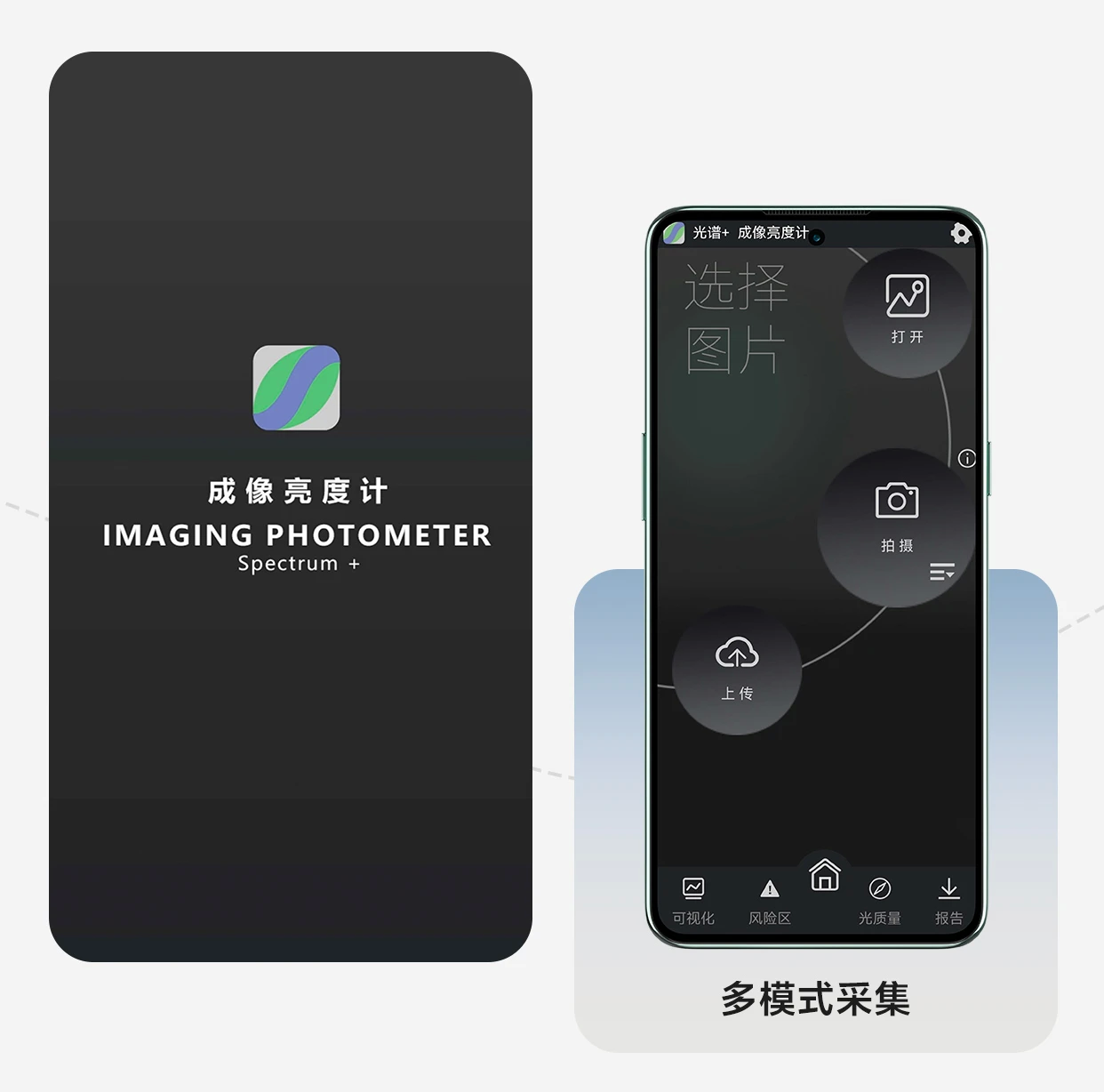
其核心功能包括:动态亮度分布成像、蓝光危害指数计算、昼夜节律影响评估、生态光污染分析等,精准捕捉天然光与人工光源的时空动态特征。该工具内置国际照明标准与生态评估模型,可一键生成包含亮度统计、光谱分析、健康风险提示的专业报告。
该工具通过手机摄像头即可生成二维伪色分布图,直观呈现空间光强分布与光谱组成。例如在建筑采光研究中,可同步分析窗景的动态光谱特性与室内照度分布,为优化天然光利用提供数据支撑。对于办公环境,其智能评估体系能量化不同光源对视觉舒适度、昼夜节律的影响程度,辅助设计师打造更健康的光环境。
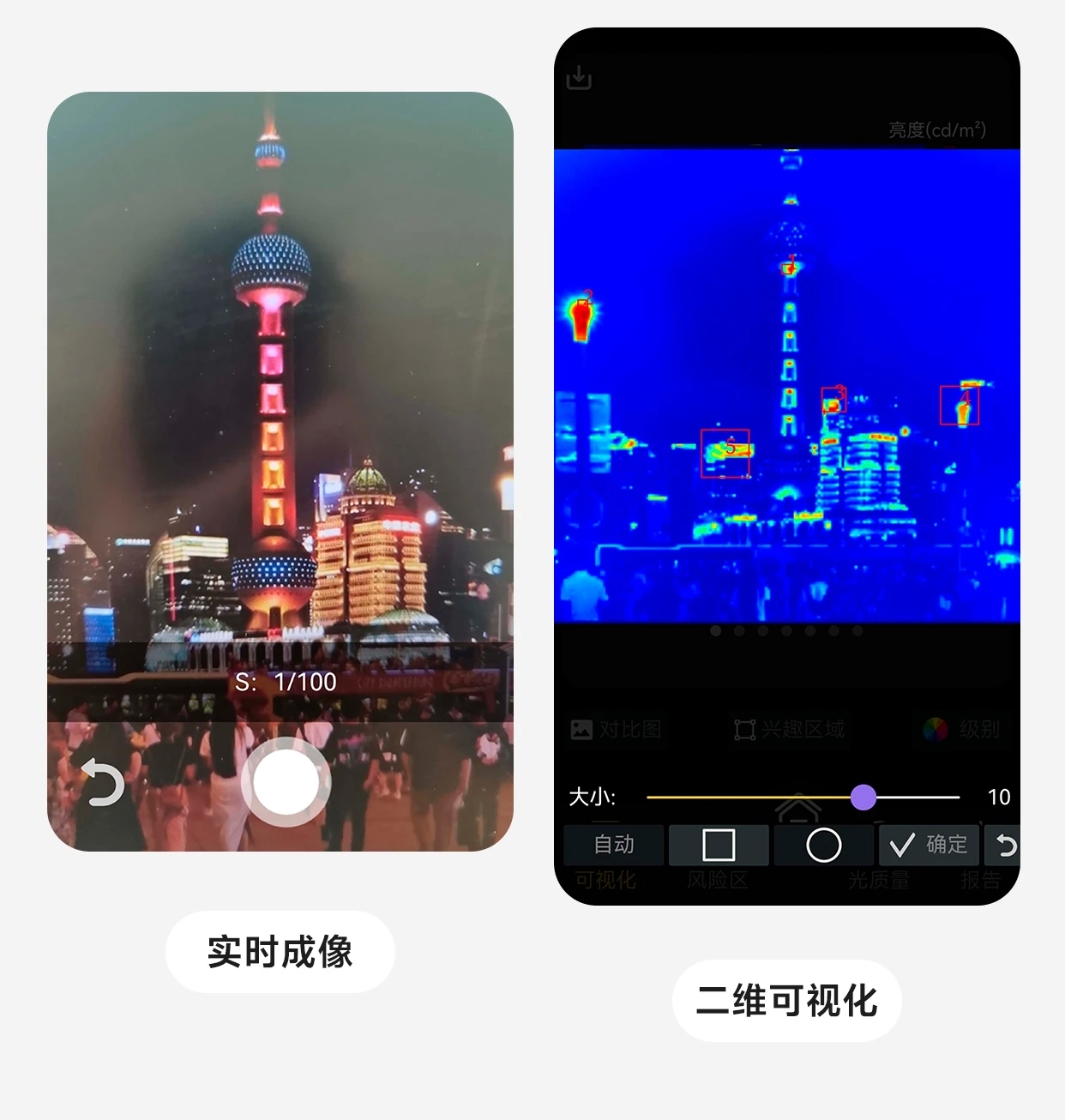
无论是研究人员开展流行病学调查,还是设计师进行采光方案优化,或是普通用户改善居家照明,均可通过这一便携式工具实现 "光环境有数可依",让健康与舒适的光照条件成为日常生活的标配。
使用、咨询或购买请长按下方二维码:

转载文章并不代表中国之光网赞同其观点和立场。
涉及内容版权、真实性或其它问题,请致电:0510-85188298 ,我们将第一时间处理。










